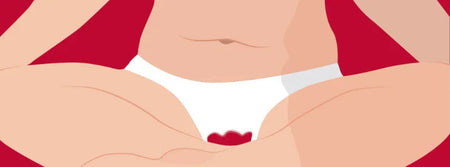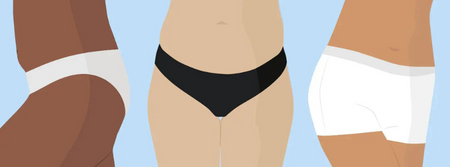Health myths develop because, sadly, many people feel embarrassed or ashamed talking about problems “down there.” Because we are committed to helping people learn more about how their own bodies work and menstrual health, Ruby Cup is all about busting menstrual cup myths. Today we’re talking about pelvic organ prolapse and dispelling the myth that using a menstrual cup can cause prolapse. Don’t let some menstrual health misinformation stand in the way of you discovering Ruby Cup’s comfortable, long-lasting, and planet-friendly menstrual cup.
Want a zero-waste and fuss-free period? For every Ruby Cup purchased, we donate another one to a person without access to safe menstrual products. Get your Ruby Cup now.
This article is written by medical professional Amy Harris. Read more about Amy Harris at the end of the article.
First things first, what is pelvic organ prolapse (POP)?
Your pelvis is the bowl shaped lower part of your belly — home to your bladder, bowel (intestines), ovaries, and uterus (womb). The pelvic floor is what we call the hammock of muscle and connective tissue (your body’s version of plastic wrap) that supports your pelvic organs and keeps them from falling out of your vagina.
Pelvic floor prolapse (POP for short) happens when your pelvic floor muscles weaken, loosen, or are injured. Just like an old hammock sags and develops holes over time, your muscular pelvic floor hammock can relax enough so that one or more of your pelvic organs drop or press into or out of the vagina. This bulging or pressing of pelvic organs is called pelvic organ prolapse.
Pelvic organ prolapse is not life-threatening and can be treated.

Why can’t a menstrual cup cause pelvic organ prolapse?
Menstrual cups do not create enough suction (or downward force) on your pelvic floor to cause the kind of damage or weakening needed for pelvic organ prolapse. Even after monthly use of menstrual cups for say ten years (Ruby Cup’s lifespan). In truth, period cups don’t really form a direct or powerful vacuum suction, at least not the hoover-strength force the word suction conjures up in your mind.
The soft, 100% medical grade silicone walls and rim of Ruby Cup rest up against the walls of your vagina and maybe the tip of your cervix (the muscular opening to your uterus). Ideally a well-fitting menstrual cup creates a leak-proof seal, but not suction. The ideal location for your menstrual cup is below your cervix. Part of finding the right size menstrual cup is finding a menstrual cup which does not rub up against or sit too close to your cervix.
It is unusual to experience menstrual cup pain. Menstrual cup pain can rarely be caused if your menstrual cup is too close to your cervix and suctions to your cervix. A smaller-sized cup may be the best menstrual cup for a low cervix and can help keep this from happening.
Remember though, even if your menstrual cup attaches to your cervix and you pull down on it without trying to break the seal first, you will not cause any damage or weakening to your pelvic floor muscles. Worried about your menstrual cup getting stuck? Ruby Cup’s step by step guide to removing your stuck menstrual cup can save your day.
Is a tilted uterus the same as pelvic organ prolapse?
No. A tilted uterus is different from a pelvic organ prolapse because a tilted uterus is still in the right place within your pelvis. It does not bulge into your vagina, causing unpleasant symptoms.
Instead, a tilted uterus just means that the uterus leans either forwards or backwards in the pelvis. Sometimes, it can be tricky to find the best menstrual cup for a tilted uterus, but in general a smaller-sized cup with a shorter or trimmable stem is the way to go. Even with a tilted uterus you can still enjoy all of the amazing Earth-friendly benefits of a menstrual cup.

What causes pelvic organ prolapse if a menstrual cup can’t?
The most common causes of pelvic organ prolapse (in order of most common to least common) are:
- Vaginal childbirth, especially the more vaginal deliveries you have or the larger your babies
- Long-term pressure on your belly. Causes of this pressure are being overweight, chronic coughing, or straining often during bowel movements
- Repeated heavy lifting, like working in a factory or distribution center
- Aging. Pelvic floor disorders are more common in older women
- Hormonal changes during menopause
- Family history
Labor and pushing a baby out of your vagina can stretch and strain the pelvic floor. But, you can still get prolapse even if you have never had children or if you had a cesarean, or C-section, delivery.
How do I know if I have pelvic organ prolapse?
You may not know if you have pelvic organ prolapse. With mild pelvic organ prolapse (POP), you may not have any symptoms. Only one out of every three women with POP has symptoms. Some women notice their symptoms are worse at certain times of the day — like during physical activity or after standing for a long time.
The most common symptoms of pelvic organ prolapse are:
- Seeing or feeling pressure or a bulge in your vagina
- Feeling aching, discomfort or fullness in your pelvis
- Leaking urine or having trouble with bowel movements
- Having trouble inserting your tampon or period cup
- A feeling of pelvic pressure that gets worse as the day goes on or with coughing and sneezing
- Pain or discomfort with sexual intercourse

Your healthcare provider may be the one to break the news to you that you have pelvic organ prolapse: When examined, doctors diagnose about half of all women ages 60-69 with POP.
In general, you do not need to worry about whether or not you have POP unless you are experiencing any symptoms that are making your life more difficult or unpleasant. Your healthcare provider can help answer whether or not you have pelvic organ prolapse. Too few women talk to their providers about POP or embarrassing symptoms like leaking urine when coughing or vaginal “farts” in upside-down yoga poses. Finding a provider you trust and feel comfortable enough with to ask your most embarrassing or personal questions can lead the way to better sexual and reproductive health.
If I have pelvic organ prolapse can I still use a menstrual cup?
The simple answer is yes. The more accurate answer is, it depends. There are different types of pelvic organ prolapse. There is also a range in how bad the prolapse or weakening of your pelvic floor is — from a slight loosening to your uterus falling outside of your vagina.
Women who have symptoms from POP or who know they have more advanced POP may not be able to use a menstrual cup. A certain amount of resistance or strength is needed in the walls of your vagina and against your pelvic floor to hold a menstrual cup in place. If you have weak vaginal tone (floppy vaginal walls in non-scientific lingo), the cup could slip down to a less comfortable position or tilt sideways so that it leaks.
The best way to know whether or not you can use a period cup if you have POP is to talk with the healthcare provider who diagnosed you with POP in the first place. Hopefully, they referred you to a rock-star pelvic floor physical therapist for treatment. If you didn’t know already, pelvic floor physical therapists can be hugely helpful in treating many women’s health problems, including pelvic organ prolapse. In the U.S. you can search online for a specially-trained women’s health physical therapist, or ask your healthcare provider for a referral to start getting some answers.
If you have POP, menstrual cups should not pose any risk of making your prolapse worse; however, always break the seal when removing it to avoid any issues with organ position, just in case.
Can pelvic organ prolapse be treated?
The right treatment for your POP depends on the type of prolapse you have, your symptoms, your age, other health problems, and whether you are sexually active.
POP treatment options may include some combination of any of the following:
- Pelvic floor physical therapy
- Pessary
- Dietary counseling and change in eating habits
- Surgery
POP symptoms, like vaginal pressure can improve if the organ can be pushed back into place. Medical devices called pessaries, fitted by your provider or pelvic floor physical therapist, can help support your organs and keep you comfortable. Some get relief just by wearing a tampon or even their menstrual cup. This happens because the cup pushes the organs back into a more stable and comfortable position.
Specialized muscle training and therapy of your pelvic floor muscles (called pelvic floor physical therapy) works to reduce POP symptoms. We all have heard of Kegel exercises before, and you probably just squeezed as you read this. But did you know that 30% of women do Kegels incorrectly? All the more reason to go back to Kegel boot camp with a pelvic floor physical therapist and maybe even a Kegel trainer like the Ruby Kegel Trainer.
Pelvic floor muscle training can help with some POP symptoms such as leaking urine, although it can not reverse POP. Surgery is usually recommended for more severe cases of POP.
How can I prevent pelvic organ prolapse?
As with many health conditions, there are some things you can change and others you can’t. While you may not be able to control whether you have a 10 pound baby or your family history of pelvic organ prolapse, there are ways to lend your pelvic floor a helping hand. Two-for-one bonus- many of the prolapse-prevention tips are good for your overall health. You might already be doing some of them, so your pelvic floor muscles thank you!
- Avoid constipation (pooping less than 3 times a week). Drink plenty of water and eat whole grains, fruits and vegetables.
- Don’t strain (push) when trying to poop.
- Learn how to do Kegel exercise correctly and start a Kegel full workout plan.
- Quit smoking to avoid chronic coughing.
- Maintain a healthy weight.
- Talk with your childbirth provider about labor and pushing techniques to reduce your chances for pelvic floor injury during childbirth.
- Consider pelvic floor physical therapy both during pregnancy and after delivery to keep your pelvic floor in top working order.
- Always break the suction on your menstrual cup before pulling down to remove it.
Note: There is no evidence that menstrual cups can cause prolapse, even if you were to not break the suction and remove them with force repeatedly. Likewise, we know that using menstrual cups will not stretch you out.
By busting menstrual cup myths, Ruby Cup can help you learn more about what is normal for your body and for your stage in life. Using a menstrual cup helps you learn more about any changes in your body. If you notice symptoms such as a lump in your vagina, leaking urine, or problems with sexual intercourse, it is time to give your provider a ring. We at Ruby Cup are committed to destigmatizing menstruation and health conditions such as pelvic prolapse. Knowledge is power as they say, and no person with a uterus should have their potential limited by pelvic organ prolapse or their period.
FAQs
What is the best menstrual cup for prolapse?
In general, if you know that you have a weakened pelvic floor, relaxed vaginal tone, problems with incontinence, or pelvic organ prolapse look for:
- Larger-sized cups
- Cups with thicker rims
- Cups made from thicker, more rigid silicone
These features will make it easier for the cup to stay in the right position and less likely to fall out. They could also improve your POP symptoms by helping to keep your pelvic organs in the right place.
Can a menstrual cup cause uterine prolapse?
No, a menstrual cup can not cause uterine prolapse. Menstrual cup usage has not been linked to pelvic prolapse in any studies and a review of menstrual cups in the Lancet medical journal in 2019 declared menstrual cups to be safe. There is also no evidence menstrual cups stretch you out or change the muscular tone of your vagina.
Can you use a menstrual cup with a prolapsed uterus?
Yes. Depending on the degree of your prolapse (how much your uterus bulges into or out of your vagina), a period cup could still be an option for you. If you have a lot of prolapse, it is possible that your prolapsed uterus could push the period cup out of your vagina or into a less comfortable position. The best way to find out whether or not you can use a period cup is to talk with the healthcare provider who diagnosed you with your prolapsed uterus.
Can I use a menstrual cup with a prolapsed bladder?
Yes. Depending on how weak your pelvic floor is or how bad your prolapsed bladder may be, you may still be able to use a menstrual cup. The medical name for a prolapsed bladder is cystocele.
A prolapsed bladder is the most common type of pelvic organ prolapse and usually causes you to leak urine, maybe when coughing, sneezing, or jumping.
The best way to know whether you will be able to use a menstrual cup with your prolapsed bladder is to ask your provider’s opinion. You could also just try it and see: Worst case, your period cup falls out or leaks, best case scenario your period cup decreases leaking because the cup holds your bladder more upright.
Want a zero-waste and fuss-free period? For every Ruby Cup purchased, we donate another one to a person without access to safe menstrual products. Get your Ruby Cup now.
Written by Amy Harris.
Amy Harris is a certified nurse-midwife with more than a decade of clinical experience in reproductive health clinics, hospitals, and private OB/GYN practices. Amy holds a Masters of Science in Maternal and Child Health from Harvard School of Public Health and completed her nursing and midwifery training at Yale School of Nursing and Boston University School of Public Health. Passionate about empowering women through health education, Amy puts her public health training to work as a dedicated women’s health writer.










